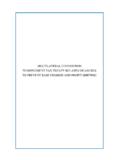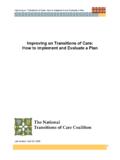Transcription of RADIATION SAFETY POLICY MANUAL - University …
1 RADIATION SAFETY POLICY MANUALP repared and issued under the auspices ofTHE RADIATION SAFETY COMMITTEEJune 1996 For additional information, contactTHE RADIATION SAFETY OFFICERR adiological Health Department260 S Central Campus Drive, Room 100581-6141iForewordIonizing RADIATION provides the University community with a powerful tool formedicine and research. The beneficial applications of RADIATION continue to grow asscientists delve ever further into the workings of our bodies, our environment and ouruniverse. In addition to the benefits derived from the use of RADIATION , however, there arerisks that must be recognized and controlled.
2 The assessment and management of theserisks is, itself, a scientific discipline that provides the basis for the contents of this responsibility for establishing RADIATION protection policies and for authorizingthe use of specific RADIATION sources at the University of Utah is delegated to the RadiationSafety Committee. This RADIATION SAFETY POLICY MANUAL contains the general policies andprocedures adopted by the Committee for the safe use of ionizing RADIATION in teaching,research and clinical medicine. Additional procedures containing detailed instructions forspecific sources or categories of use are available from the Committee through the RadiationSafety Officer.
3 Authorization for the use of any licensed or registered RADIATION source isconditional upon complete compliance with federal and state regulations, license conditionsand with the policies and procedures promulgated by the RADIATION SAFETY the use of RADIATION sources is governed by complex regulations and licenseconditions, the knowledge and performance required of individual RADIATION users is readilycomprehended and accomplished. It is the responsibility of each individual who works withsources of ionizing RADIATION to know and follow the policies and procedures promulgatedby the RADIATION SAFETY Committee and administered by the RADIATION SAFETY F.
4 Gesteland, President for ResearchDistinguished Professor, GeneticsiiTHIS PAGE INTENTIONALLY LEFT BLANKiiiTABLE OF Telephone FOR RADIATION PROTECTION Health of RADIATION Dose - Quantities and Doses and Dose SAFETY SAFETY Drug Research Reactor SAFETY Health OF RADIATION X-ray SAFETY AND MONITORING OF EXPOSURES TO EXTERNAL RADIATION X-ray Units ..10 Radioactive Evaluation and Dosimeters (Badges)..10 Investigation OF CONTENTS(Continued)ivCONTROL AND MONITORING OF INTAKE OF EXPOSURE INVESTIGATIONS AND AND Fees or EVALUATIONS; SURVEYS AND SOURCE LEAK OF AND SHIPMENT OF RADIOACTIVE WASTE SAFETY POLICY MANUAL (6/96) - Page 1 RADIATION EMERGENCYNOTIFICATION & ASSISTANCEA mbulance.
5 Fire Department9-911 University Police585-2677 Radiological Health Department & RADIATION SAFETY Officer581-6141(Calls are forwarded to the UniversityPolice Dispatcher at night or onweekends)MEDICAL RADIATIONEMERGENCIESU niversity Hospital Emergency Department581-2291(Ask for the Charge Nurse or theAttending Physician and specify"Medical RADIATION emergency") RADIATION SAFETY POLICY MANUALPURPOSEThis MANUAL conveys the official policies of the Universityof Utah for the control of all sources of, and exposures to,ionizing RADIATION that are within the jurisdiction of theUniversity. The MANUAL defines responsibilities ofindividuals and organizations for RADIATION control, itspecifies the policies that guide specific decisions onradiation control matters, and it provides general safetyrules and procedures that are obligatory for all users ofradiation sources.
6 Additional requirements and proceduresnot included in this MANUAL are developed, promulgatedand enforced as necessary to implement the overallphilosophy and policies for RADIATION protection as pre-sented and state regulations require a written radiationprotection program that includes provisions for keepingdoses as low as reasonably achievable (ALARA). Allradiation users shall be included in the program and shallbe informed of the program and of their individualresponsibilities. This MANUAL is intended to satisfy theseregulatory PROCEDURESR adiation EmergencyAny accident, injury or loss of control of a RADIATION sourcethat could cause an excessive or uncontrolled radiationexposure to any individual is referred to as a radiationemergency.
7 The proper response to any radiationemergency depends upon a thorough understanding of themagnitude of risks, priorities for action and the applicationof common sense. Each user of RADIATION sources shouldbe familiar with the basic emergency responses listedbelow and methods for applying them in his or her ownwork area. Detailed instructions for coping with radiationemergencies are prepared only for a few special facilitiesand a few categories of emergency response "Emergency Guide" in the front of the Campus Direc-tory provides general instructions on what to do in variouskinds of emergency Public SAFETY Department is responsible for overallemergency response communication and notification of appropriate response personnel andestablishment of necessary communications links duringemergencies are services provided by Public RADIATION SAFETY Officer (RSO)
8 Is responsible forproviding technical guidance and assistance on allemergencies involving or potentially involving radio-activity or RADIATION exposures. The Radiological HealthDepartment shall be notified promptly of all accidentsor incidents involving RADIATION sources at the Universityof Utah. Members of the Radiological Health Departmentare authorized to act on behalf of the RSO and providethe staff and facilities to deal with RADIATION users of RADIATION sources are responsiblefor clean up of spilled materials and for assuring that allindividuals within their jurisdiction comply with moni-toring and reporting requirements established by the SAFETY POLICY MANUAL (6/96) - Page 2 Facilities or groups with unique RADIATION emergencyresponse requirements shall maintain and use detailedemergency procedures applicable to their People!
9 The first consideration in any emergency is to assistinjured persons and to prevent any further injury. Formedical assistance, dial 9-911 immediately and report thenature of the illness or injury. If the person may becontaminated with radioactive material, inform the 911dispatcher of the situation. If you are qualified to renderfirst aid, do so without regard to the presence of radio-activity. There are no RADIATION sources at theUniversity that produce RADIATION exposure risks largeenough to prevent giving first aid! Except for the usualprecautions for moving an injured person, individualsshould immediately leave the room or area until the extentof the radiological hazard has been evaluated.
10 However,all individuals should remain available in the vicinity untilchecked for contamination or Help!Each individual using RADIATION sources should know inadvance who to call in case of a RADIATION emergency. Iffire, injury or other emergency conditions in addition toradiation are involved, first call the appropriate numberslisted in the front of the Campus Directory. Then call theRadiological Health Department (1-6141) during normaloffice hours; or call the University Police (5-2677) duringoff-duty reporting any emergency, be sure to state the exactnature of the emergency; then give your name and thephone number from which you are calling, the exactlocation of the emergency (building, room, nearestentrance, etc.)






